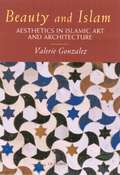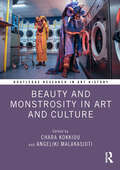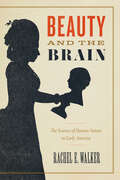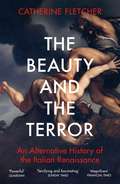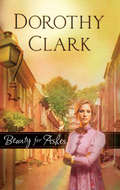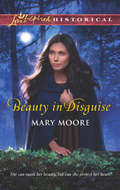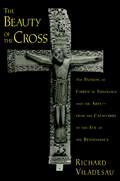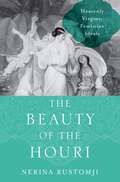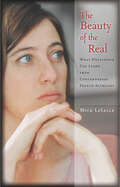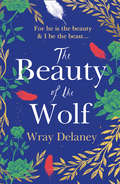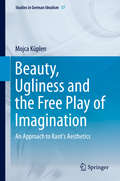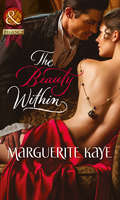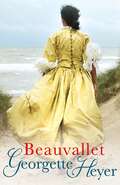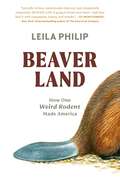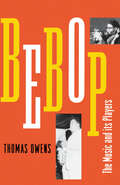- Table View
- List View
Beauty and Islam: Aesthetics in Islamic Art and Architecture
by Valerie GonzalezThis illustrated volume of five essays explores aspects of aesthetics in classical Islamic thought in the light of contemporary theories, offering new perspectives on Islamic art and architecture with examples ranging from the Qur'an and the Alhambra to the works of present day artists and philosophers. Tracing the roots of Islamic aesthetics back to the works of the great philosophers of the Middle Ages such as Avicenna and Averroes, Gonzalez finds that aesthetic theory in Islam must be seen within the much wider context of parallel thinking on theology, ethics, physics and metaphysics. She balances her analysis of this philosophy (moral, logical and scientific) of beauty with the equally important analysis of the perceptual experience of beauty. Her study covers the breadth and depth of the experience, understanding and formulation of beauty as it has been seen through Islamic eyes.
Beauty and Monstrosity in Art and Culture (Routledge Research in Art History)
by Chara Kokkiou Angeliki MalakasiotiThis edited volume takes a new look at an old question: what is the relationship between beauty and monstrosity? How has the notion of beauty transformed through the years and how does it coincide with monstrous ontologies? Contributors offer an interdisciplinary approach to how these two concepts are interlinked and emphasize the ways the beautiful and the monstrous pervade human experience.The two notions are explored through the axis of human transformation, focusing on body, identity, and gender, while questioning both how humans transform their body and space as well as how humans themselves are gradually transformed in different contexts. The pandemic, gender crisis, moral crisis, sociocultural instability, and environmental issues have redefined beauty and the relationship we have with it. Exploring these concepts through the lens of human transformation can yield valuable insights into what it means to be human in a world of constant change.The book will be of interest to scholars working in art history, archaeology, philosophy, architecture, and cultural studies.
Beauty and Monstrosity in Art and Culture (Routledge Research in Art History)
This edited volume takes a new look at an old question: what is the relationship between beauty and monstrosity? How has the notion of beauty transformed through the years and how does it coincide with monstrous ontologies? Contributors offer an interdisciplinary approach to how these two concepts are interlinked and emphasize the ways the beautiful and the monstrous pervade human experience.The two notions are explored through the axis of human transformation, focusing on body, identity, and gender, while questioning both how humans transform their body and space as well as how humans themselves are gradually transformed in different contexts. The pandemic, gender crisis, moral crisis, sociocultural instability, and environmental issues have redefined beauty and the relationship we have with it. Exploring these concepts through the lens of human transformation can yield valuable insights into what it means to be human in a world of constant change.The book will be of interest to scholars working in art history, archaeology, philosophy, architecture, and cultural studies.
Beauty and the Baron (Mills And Boon Historical Ser.)
by Deborah HaleCOULD SHE DEFEAT HIS DARKNESS AND BRING HIM BACK TO LIFE? Handsome rakehell turned scarred recluse Lord Lucius Daventry returns from battle intent on forgetting the past. Yet, once home, Lucius is presented with one final mission: marry Angela Lacewood and grant his ailing grandfather’s dying wish.
Beauty and the Brain: The Science of Human Nature in Early America
by Rachel E. WalkerExamining the history of phrenology and physiognomy, Beauty and the Brain proposes a bold new way of understanding the connection between science, politics, and popular culture in early America. Between the 1770s and the 1860s, people all across the globe relied on physiognomy and phrenology to evaluate human worth. These once-popular but now discredited disciplines were based on a deceptively simple premise: that facial features or skull shape could reveal a person’s intelligence, character, and personality. In the United States, these were culturally ubiquitous sciences that both elite thinkers and ordinary people used to understand human nature. While the modern world dismisses phrenology and physiognomy as silly and debunked disciplines, Beauty and the Brain shows why they must be taken seriously: they were the intellectual tools that a diverse group of Americans used to debate questions of race, gender, and social justice. While prominent intellectuals and political thinkers invoked these sciences to justify hierarchy, marginalized people and progressive activists deployed them for their own political aims, creatively interpreting human minds and bodies as they fought for racial justice and gender equality. Ultimately, though, physiognomy and phrenology were as dangerous as they were popular. In addition to validating the idea that external beauty was a sign of internal worth, these disciplines often appealed to the very people who were damaged by their prejudicial doctrines. In taking physiognomy and phrenology seriously, Beauty and the Brain recovers a vibrant—if largely forgotten—cultural and intellectual universe, showing how popular sciences shaped some of the greatest political debates of the American past.
Beauty and the Male Body in Byzantium: Perceptions and Representations in Art and Text
by M. HatzakiA neglected aspect of Byzantium, physical beauty appears as a quality with an unmistakable dark side, relating ambiguously to notions of power, goodness, evil, masculinity, effeminacy, life and death. Examined as an attribute of the human and, in particular, of the male body, this study of beauty refines our understanding of the Byzantine world.
The Beauty and the Terror: An Alternative History of the Italian Renaissance
by Catherine FletcherThe Italian Renaissance shaped Western culture - but it was far stranger and darker than many of us realise.'Brilliant and gripping, here is the full true Renaissance in a history of compelling originality and freshness' Simon Sebag MontefioreWe know the Mona Lisa for her smile, but not that she was married to a slave-trader. We revere Leonardo da Vinci for his art, but few now appreciate his ingenious designs for weaponry. We visit Florence to see Michelangelo's David, but hear nothing of the massacre that forced the republic's surrender. In fact, many of the Renaissance's most celebrated artists and thinkers emerged not during the celebrated 'rebirth' of the fifteenth century but amidst the death and destruction of the sixteenth century.The Beauty and the Terror is an enrapturing narrative which includes the forgotten women writers, Jewish merchants, mercenaries, prostitutes, farmers and citizens who lived the Renaissance every day. Brimming with life, it takes us closer than ever before to the reality of this astonishing era, and its meaning for today.'Terrifying and fascinating' Sunday Times'Enlightening...exactly the alternative history you might wish for' Daily Telegraph
Beauty for Ashes (Mills And Boon Silhouette Ser.)
by Dorothy ClarkIn the prim-and-proper Philadelphia of 1820, a shocking marriage…
Beauty in Disguise (Mills And Boon Love Inspired Historical Ser.)
by Mary MooreHIDDEN IN PLAIN SIGHT After her scandalous first Season, Lady Kathryn needs a new beginning. Concealing her stunning hair and sapphire eyes beneath a dowdy façade, she’s grateful to earn her keep as companion Kate Montgomery. Until she comes face to face with her past in Lord Dalton, the only man she has ever loved.
Beauty is in the Street: Protest and Counterculture in Post-War Europe
by Joachim C. Häberlen'A rich and readable account of left-wing activism in the West and opposition to Soviet-style communism in the East' Katja Hoyer, The Spectator'A dream, perhaps, but one that still sounds worth fighting for, even beautiful' Stuart Jeffries, The Observer'An ambitious and masterly account of utopian protest in Europe ... Fast-paced, with an eye for telling detail and written with a light touch' Robert GildeaIn post-war Europe, protest was everywhere. On both sides of the Iron Curtain, from Paris to Prague, Milan to Wroclaw, ordinary people took to the streets, fighting for a better world. Their efforts came to a head most dramatically in 1968 and 1989, when mass movements swept Europe and rewrote its history.In the decades between, Joachim C. Häberlen argues, new movements emerged that transformed the nature of protesting. Activism moved beyond traditional demonstrations, from squatting to staging 'happenings' and camping out at nuclear power plants. People protested in the way they dressed, the music they listened to, the lovers they slept with, the clubs where they danced all night. New movements were born, notably anti-racism, women's liberation, gay liberation, and environmentalism. And protest turned inward, as activists experimented with new ways of living and feeling, from communes to group therapy, in their efforts to live a better life in the here and now.Some of these struggles succeeded, others failed. But successful or not, their history provides a glimpse into roads not taken, into futures that did not happen. The stories in Häberlen's book invite us to imagine different futures; to struggle, to fail, and to try again. In a time when we are told that there are no alternatives, they show us that there could be another way.
Beauty is Nowhere: Ethical Issues in Art and Design (Critical Voices in Art, Theory and Culture)
by Saul OstrowFirst Published in 1998. Routledge is an imprint of Taylor & Francis, an informa company.
Beauty is Nowhere: Ethical Issues in Art and Design (Critical Voices in Art, Theory and Culture)
by Saul OstrowFirst Published in 1998. Routledge is an imprint of Taylor & Francis, an informa company.
Beauty Like the Night: Spymaster 6 Spymaster (Spymaster)
by Joanna BourneIn Beauty Like The Night, Joanna Bourne, 'master of romance and suspense' (Teresa Medeiros) returns to the French Revolution, with a stirring tale of intrigue, espionage, and irresistible attraction. For fans of Stephanie Laurens, Elizabeth Hoyt For fans of Stephanie Laurens, Elizabeth Hoyt and Poldark, this is a must-read. Severine de Cabrillac, orphan of the French revolution and sometime British intelligence agent, has tried to leave spying behind her. Now she devotes herself to investigating crimes in London and finding justice for the wrongly accused.Raoul Deverney, an enigmatic half-Spaniard with enough secrets to earn even a spy's respect, is at her door demanding help. She's the only one who can find the killer of his long-estranged wife and rescue her missing fourteen-year-old daughter.Severine reluctantly agrees to aid him, even though she knows the growing attraction between them makes it more than unwise. Their desperate search for the girl unleashes treason and murder...and offers a last chance for two strong, wounded people to find love.For more spellbinding Spymasters romance, look for the other titles by Joanna Bourne: The Forbidden Rose, The Spymaster's Lady, My Lord and Spymaster, The Black Hawk and Rogue Spy.
The Beauty of the Cross: The Passion of Christ in Theology and the Arts from the Catacombs to the Eve of the Renaissance
by Richard ViladesauFrom the earliest period of its existence, Christianity has been recognized as the "religion of the cross." Some of the great monuments of Western art are representations of the brutal torture and execution of Christ. Despite the horror of crucifixion, we often find such images beautiful. The beauty of the cross expresses the central paradox of Christian faith: the cross of Christ's execution is the symbol of God's victory over death and sin. The cross as an aesthetic object and as a means of devotion corresponds to the mystery of God's wisdom and power manifest in suffering and apparent failure. In this volume, Richard Viladesau seeks to understand the beauty of the cross as it developed in both theology and art from their beginnings until the eve of the renaissance. He argues that art and symbolism functioned as an alternative strand of theological expression -- sometimes parallel to, sometimes interwoven with, and sometimes in tension with formal theological reflection on the meaning of the Crucifixion and its role insalvation history. Using specific works of art to epitomize particular artistic and theological paradigms, Viladesau then explores the contours of each paradigm through the works of representative theologians as well as liturgical, poetic, artistic, and musical sources. The beauty of the cross is examined from Patristic theology and the earliest representations of the Logos on the cross, to the monastic theology of victory and the Romanesque crucified "majesty," to the Anselmian "revolution" that centered theological and artistic attention on the suffering humanity of Jesus, and finally to the breakdown of the high scholastic theology of the redemption in empirically concentrated nominalism and the beginnings of naturalism in art. By examining the relationship between aesthetic and conceptual theology, Viladesau deepens our understanding of the foremost symbol of Christianity. This volume makes an important contribution to an emerging field, breaking new ground in theological aesthetics. The Beauty of the Cross is a valuable resource for scholars, students, and anyone interested in the passion of Christ and its representation.
The Beauty of the Cross: The Passion of Christ in Theology and the Arts from the Catacombs to the Eve of the Renaissance
by Richard ViladesauFrom the earliest period of its existence, Christianity has been recognized as the "religion of the cross." Some of the great monuments of Western art are representations of the brutal torture and execution of Christ. Despite the horror of crucifixion, we often find such images beautiful. The beauty of the cross expresses the central paradox of Christian faith: the cross of Christ's execution is the symbol of God's victory over death and sin. The cross as an aesthetic object and as a means of devotion corresponds to the mystery of God's wisdom and power manifest in suffering and apparent failure. In this volume, Richard Viladesau seeks to understand the beauty of the cross as it developed in both theology and art from their beginnings until the eve of the renaissance. He argues that art and symbolism functioned as an alternative strand of theological expression -- sometimes parallel to, sometimes interwoven with, and sometimes in tension with formal theological reflection on the meaning of the Crucifixion and its role insalvation history. Using specific works of art to epitomize particular artistic and theological paradigms, Viladesau then explores the contours of each paradigm through the works of representative theologians as well as liturgical, poetic, artistic, and musical sources. The beauty of the cross is examined from Patristic theology and the earliest representations of the Logos on the cross, to the monastic theology of victory and the Romanesque crucified "majesty," to the Anselmian "revolution" that centered theological and artistic attention on the suffering humanity of Jesus, and finally to the breakdown of the high scholastic theology of the redemption in empirically concentrated nominalism and the beginnings of naturalism in art. By examining the relationship between aesthetic and conceptual theology, Viladesau deepens our understanding of the foremost symbol of Christianity. This volume makes an important contribution to an emerging field, breaking new ground in theological aesthetics. The Beauty of the Cross is a valuable resource for scholars, students, and anyone interested in the passion of Christ and its representation.
The Beauty of the Houri: Heavenly Virgins, Feminine Ideals
by Nerina RustomjiA captivating look at the history of the pure females of Islamic paradise known as the houri The fascination with the houri, the pure female of Islamic paradise, began long before September 11, 2001. Beauty of the Houri: Heavenly Virgins, Feminine Ideals demonstrates how the ambiguous reward of the houri, mentioned in the Qur)qan and developed in Islamic theological writings, has gained a distinctive place in the cultural eye from the seventeenth to the twenty-first century. The houri had multiple functions in Islamic texts that ranged from caretaker, to pure companion, to personal entertainment. French, English, and American writers used the houri to critique Islam and Muslim societies, while also adopting the houri as a model of feminine beauty. Unlike earlier texts that presented different forms of the houri or universalized the houri for all women, writings about the houri after September 11th offer contradictory messages about Islam. In the twenty-first century, the image of the houri has come to symbolize a reward for violence and the possibility of gender parity. As a cosmic figure that inspires enduring questions about the promise of paradise and the idealized feminine form, the houri has a singular past and broad potential for future interpretation. The Beauty of the Houri narrates an intellectual history of the houri and offers a contemporary account of how theological ambiguity has led to different interpretations of this powerfully enduring Islamic concept.
The Beauty of the Houri: Heavenly Virgins, Feminine Ideals
by Nerina RustomjiA captivating look at the history of the pure females of Islamic paradise known as the houri The fascination with the houri, the pure female of Islamic paradise, began long before September 11, 2001. Beauty of the Houri: Heavenly Virgins, Feminine Ideals demonstrates how the ambiguous reward of the houri, mentioned in the Qur)qan and developed in Islamic theological writings, has gained a distinctive place in the cultural eye from the seventeenth to the twenty-first century. The houri had multiple functions in Islamic texts that ranged from caretaker, to pure companion, to personal entertainment. French, English, and American writers used the houri to critique Islam and Muslim societies, while also adopting the houri as a model of feminine beauty. Unlike earlier texts that presented different forms of the houri or universalized the houri for all women, writings about the houri after September 11th offer contradictory messages about Islam. In the twenty-first century, the image of the houri has come to symbolize a reward for violence and the possibility of gender parity. As a cosmic figure that inspires enduring questions about the promise of paradise and the idealized feminine form, the houri has a singular past and broad potential for future interpretation. The Beauty of the Houri narrates an intellectual history of the houri and offers a contemporary account of how theological ambiguity has led to different interpretations of this powerfully enduring Islamic concept.
The Beauty of the Real: What Hollywood Can Learn from Contemporary French Actresses
by Mick LaSalleEven as actresses become increasingly marginalized by Hollywood, French cinema is witnessing an explosion of female talent—a Golden Age unlike anything the world has seen since the days of Stanwyck, Hepburn, Davis, and Garbo. In France, the joy of acting is alive and well. Scores of French actresses are doing the best work of their lives in movies tailored to their star images and unique personalities. Yet virtually no one this side of the Atlantic even knows about them. Viewers who feel shortchanged by Hollywood will be thrilled to discover The Beauty of the Real. This book showcases a range of contemporary French actresses to an audience that will know how to appreciate them—an American public hungry for the exact qualities that these women represent. To spend time with them, to admire their flashing intelligence and fearless willingness to depict life as it is lived, gives us what we're looking for in movies but so rarely find: insights into womanhood, meditations on the dark and light aspect's of life's journey, revelations and explorations that move viewers to reflect on their own lives. The stories they bring to the screen leave us feeling renewed and excited about movies again. Based on one-on-one interviews and the viewing of numerous films, Mick LaSalle has put together a fascinating profile of recent generations of French film stars and an overview of their best work. These women's insights and words illuminate his book, which will answer once and for all the two questions Americans most often have about women and the movies: Where did all the great actresses go? And how can I see their movies? Please click here to see a video discussing The Beauty of the Real at the Roxie Film Festival.
The Beauty of the Wolf
by Wray Delaney‘Amazing’ Meg Rosoff ‘Extraordinary’ Maggie Alderson ‘What some might call beauty, I find monstrous’
Beauty, Ugliness and the Free Play of Imagination: An Approach to Kant's Aesthetics (Studies in German Idealism #17)
by Mojca KüplenThis book presents a solution to the problem known in philosophical aesthetics as the paradox of ugliness, namely, how an object that is displeasing can retain our attention and be greatly appreciated. It does this by exploring and refining the most sophisticated and thoroughly worked out theoretical framework of philosophical aesthetics, Kant’s theory of taste, which was put forward in part one of the Critique of the Power of Judgment. The book explores the possibility of incorporating ugliness, a negative aesthetic concept, into the overall Kantian aesthetic picture. It addresses a debate of the last two decades over whether Kant's aesthetics should allow for a pure aesthetic judgment of ugliness. The book critically reviews the main interpretations of Kant’s central notion of the free play of imagination and understanding and offers a new interpretation of free play, one that allows for the possibility of a disharmonious state of mind and ugliness.In addition, the book also applies an interpretation of ugliness in Kant’s aesthetics to resolve certain issues that have been raised in contemporary aesthetics, namely the possibility of appreciating artistic and natural ugliness and the role of disgust in artistic representation.Offering a theoretical and practical analysis of different kinds of negative aesthetic experiences, this book will help readers acquire a better understanding of his or her own evaluative processes, which may be helpful in coping with complex aesthetic experiences. Readers will gain unique insight into how ugliness can be offensive, yet, at the same time, fascinating, interesting and captivating.
The Beauty Within: Outrageous Confessions Of Lady Deborah / The Beauty Within (Mills And Boon Historical Ser.)
by Marguerite KayeBEAUTY IS IN THE EYE OF THE BEHOLDER
Beauvallet (Historical Romances Ser. #5)
by Georgette HeyerWitty, elegant, stylish and the best comedies of manners since Jane Austen. 'Mad Nicholas' to his friends, 'Scourge of Spain' to the enemy, Sir Nicholas Beauvallet has never been known to resist a challenge.When a captured galleon yields the lovely Doña Dominica de Rada y Sylva, he vows to return her and her father to the shores of Spain. But he has no sooner done so than he proposes a venture more reckless than any of his exploits on the high seas which have made him Drake's equal and a favourite of the Queen. He will take Dominica as his bride even if he must enter the lion's den...
Beaverland: How One Weird Rodent Made America
by Leila PhilipAn intimate and revelatory dive into the world of the beaver—the wonderfully weird rodent that has surprisingly shaped American history and may save its ecological future. From award-winning writer Leila Philip, Beaverland is a masterful work of narrative science writing, a book that highlights, though history and contemporary storytelling, how this weird rodent plays an oversized role in American history and its future. She follows fur trappers who lead her through waist high water, fur traders and fur auctioneers, as well as wildlife managers, PETA activists, Native American environmental vigilantes, scientists, engineers, and the colorful group of activists known as beaver believers. Beginning with the early trans-Atlantic trade in North America, Leila Philip traces the beaver&’s profound influence on our nation&’s early economy and feverish western expansion, its first corporations and multi-millionaires. In her pursuit of this weird and wonderful animal, she introduces us to people whose lives are devoted to the beaver, including a Harvard scientist from the Blackfeet Reservation in Montana, who uses drones to create 3-dimensional images of beaver dams; and an environmental restoration consultant in the Chesapeake whose nickname is the &“beaver whisperer&”. What emerges is a poignant personal narrative, a startling portrait of the secretive world of the contemporary fur trade, and an engrossing ecological and historical investigation of these heroic animals who, once trapped to the point of extinction, have returned to the landscape as one of the greatest conservation stories of the 20th century. Beautifully written and impeccably researched, Beaverland reveals the profound ways in which one odd creature and the trade surrounding it has shaped history, culture, and our environment. The New York Times Editors' Choice NPR Science Friday Book Club Selection
Bebop: The Music and Its Players
by Thomas Owens"When bebop was new," writes Thomas Owens, "many jazz musicians and most of the jazz audience heard it as radical, chaotic, bewildering music." For a nation swinging to the smoothly orchestrated sounds of the big bands, this revolutionary movement of the 1940s must have seemed destined for a short life on the musical fringe. But today, Owens writes, bebop is nothing less than "the lingua franca of jazz, serving as the principal musical language of thousands of jazz musicians." In Bebop, Owens conducts us on an insightful, loving tour through the music, players, and recordings that changed American culture. Combining vivid portraits of bebop's gigantic personalities with deft musical analysis, he ranges from the early classics of modern jazz (starting with the 1943 Onyx Club performances of Dizzy Gillespie, Max Roach, Oscar Pettiford, Don Byas, and George Wallington) through the central role of Charlie Parker, to an instrument-by-instrument look at the key players and their innovations. Illustrating his discussion with numerous musical excerpts, Owens skillfully demonstrates why bebop was so revolutionary, with fascinating glimpses of the tempestuous jazz world: Thelonious Monk, for example, did "everything 'wrong' in the sense of traditional piano technique....Because his right elbow fanned outward away from his body, he often hit the keys at an angle rather than in parallel. Sometimes he hit a single key with more than one finger, and divided single-line melodies between two hands." In addition to his discussions of individual instruments and players, Owens examines ensembles, with their sometimes volatile collaborations: in the Jazz Messengers, Benny Golson told of how his own mellow saxophone playing would get lost under Art Blakey's furious drumming: "He would do one of those famous four-bar drum rolls going into the next chorus, and I would completely disappear. He would holler over at me, 'Get up out of that hole!'" In this marvelous account, Owens comes right to the present day, with accounts of new musicians ranging from the Marsalis brothers to lesser-known masters like pianist Michel Petrucciani. Bebop is a jazz-lover's dream--a serious yet highly personal look at America's most distinctive music.
